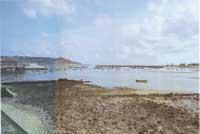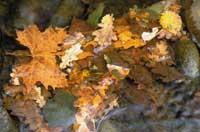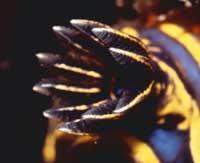The excuse of mussels, a thousand jewels of coastal ecology
1999/05/01 Pagola Carte, Santiago Iturria: Elhuyar aldizkaria
Around the mussels...
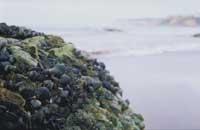
In the hard substrates of the coast, the most used are the following: 1) the threads they have developed for proper fixation to the ground (i.e. fire threads); 2) rapid growth; and 3) the triangular shape taken by reducing the front part of the body and stretching the back. In fact, combining these three characteristics, some researchers have launched the idea that success lies in the wonderful ability to move, step on or subdue the living beings around them. All this, of course, taking into account certain environmental parameters: the real success of mussels will occur, almost always, in the temperate regions of the world, in the lower areas of the intertidal zone and in the habitats of greater or half exposure (Photo 1). However, the first steps in the evolution of these bivalve mollusks seem to have taken place in the deep submarine.
At this point, without even realizing it, appears the first important concept, the zoning of the living intertidal. It is a division based on several horizontal belts of animals and plants (algae) and, although it is no other characteristic of marine ecosystems, in the rocky intertidal areas it is very remarkable (figure 2). It should be noted that the hardness of the physical factors established in these habitats by the effects of the sea and the atmosphere varies in very short stretches.
The clearest conclusion that can be drawn from this subject, which has given rise to a multitude of works of interest, is that the most important factors for the distribution of intertidal living beings can be divided into two large groups: on the one hand, physical factors (dryness of air, solar irradiation, sea storms, etc.). the most important in the upper levels or in the belts and, on the other hand, the biotic factors that can dominate in the lower levels of the intertidal zone, that is, the influences between living beings. In the latter, as we will see later, space competition is undoubtedly the main one if we talk about hard substrates.
Although we can find mussels in the seas of all temperate regions of the world… are they of the same species? No, within the family Mytilidae, although the species located in the genus Mytilus have a wider distribution, other genera such as the Modiolus may have a great importance. Biogeography has often taught us that the role or function of the species “A” in one continent is played by the species “B” in another. In short, the same ecological functions correspond to species with the same ecological requirements and it is not so difficult to find parallel species in the global distribution of a family.
This is what happens in the family Mytilidae, being the most common mussel of our coasts Mytilus galloprovincialis Lamarck, 1819. The opinions of the taxonomists on this point contrast with those of the native species ( M. galloprovincialis), which the Swedish naturalist Linné described sixty years earlier ( M. edulis Linné, 1758), and the rest estimate that both species could reside in the Basque Country. According to this opinion, the characteristics that characterize them, in addition to genetics, are morphological and depend on the habitat. Based on the latest studies, both M. galloprovincialis and M. edulis seem to be real species, but the mussels on our coast belong to the first. However, from now on we only say Mytilus (just in case).
Investments, economy and balances
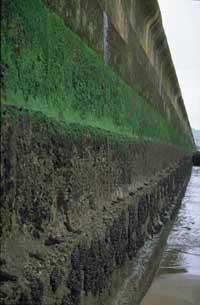
The continuous construction of a shell composed mostly of calcium carbonates is not free for the mussel. However, this structure can be a good proportion of the total weight of the animal... But why so much investment? From the role of bivalve shell, which is important for the survival of these soft animals, we immediately realize. In the case of the Mytilus bivalvos, in addition, as in the case of others like Ostrea n, the shells also serve to form balances on rocks, since they supply these peculiar communities with sufficient hardness. On the other hand, the influence of these harsh structures on the food chain is also not a joke: the energy destined to the growth of the tissues can be found soon available to the collectors, while the stored for the growth of the shell will be available for other trophic levels, but after a long period of time.
This is not the only thing we want to say about the economy of mussels. The benthic communities that make up these animals (communities with a certain relationship to the substrate in the aquatic environment) are very effective in obtaining food. Their secret lies in being filterers. Water filtration is constant, feeding mainly on the plankton that inhabits the water column, that is, microscopic living beings. But they are not the only ones, since in the marine bentos this type of food is very common (figure 3). There are several groups of filter animals based on the production of plankton, such as many cnidarios (and in them corals), sponges, briozoos, many polychaetes worms, cirripeds (barnacles and sea acorns), ascites and, of course, bivalves.
However, we should not consider it a “sink” that traps the bentos, matter and energy. Many mechanisms of energy leakage of opposite direction have been described, and as an example, perfect: most benthic animals, including our mussels, have planktonic larvae, that is, they leave the substratum and move freely in the water column until they are adults. In this sense, we can cite the theories of the bentos/plankton coupling. Very interesting, but for the moment we will only remain that, as in many places has always been learned and taught, plankton and suction cup are not two worlds totally separable, and the knowledge of one needs the help of the other.
For animals linked to the substrate, the type of food called filtration allows them to take both microscopic prey (plankton) and fractional organic matter in exchange for an energy expenditure nimino. In active filterers (that is, most of the time) the total energy demand is less than 4%, while in liabilities (some cirripedes, for example) the expenditure is close to zero. If you have to wait for the “fallen food from the sky”, it is not difficult to imagine what is the struggle between the filtering ones: occupy the substratum. As the filtering machines of different groups of animals have been improved over the course of evolution, there have been inventions towards effective forms of space filling.
Therefore, faced with one of the biggest drawbacks of hard substrates, the two-dimensional character, some animals have invented a third dimension, the most obvious case being that of corals. Moreover, both in these cnidarios and in some sponges, briozoos and ascidians, we can observe the development of colonialism. The strategy of formation of colonies is of great importance to face the problem of space, but we can also find a strategy similar to that of the coast: blankets or balances, that is, another way to achieve a continuous overlap of the same species. As the reader will already know, many Mytilus communities are like that. Also the cirripeds ( Balanus, Chthamalus) that occupy especially the upper intertidal levels. Beware, for these animals do not form a colony!
A living being closely related to the population
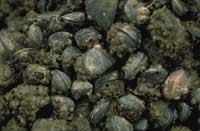
We have not yet made little mention of algae, but its importance in coastal habitats is very high. In fact, to determine the aforementioned zoning belts are the living beings that carry the most weight. Once solar energy is usable for other living beings, it must not be said that they have a special role in food chains. However, before we talked about the superiority of the filter... Algae and filter animals compete in the intertidal areas of our latitudes. Each of them “wins” depends on factors such as wave exposure, intertidal belt height and the concentration of organic matter that carries water. The high values of these parameters, in general, are related to the victory of the filter. In the lower levels of the intertidal area, in addition, the predominance of mussels can occur.
The high concentration of organic matter is an indicator of some “contamination”. This pollution can be “natural”, for example in the rías, but in some bays of our coast it is only human pollution. In addition to dominating intertidal areas, achieving significant overlap levels of mussels in submarine habitats can be considered a serious problem. In the first submarine meters, in reality, we have a photophilic part (very influenced by light) where the development of algae should be fundamental. Since the particles dragged by the water do not let light rays pass and these particles are a wonderful power supply for the filter, the growth of the algae is reduced. At this point it can be quite interesting the case of the surroundings of the collector of Sagüés de Donostialdea referred to by Ibáñez: In 1978 the balance of high density mussels increased. Years later, after the closure of the slaughterhouse in the neighborhood of Gros, it disappeared. In this context, the same author stressed that in 1935 the naturalist Fischer-Piette considered this mollusc peaceful on the Basque coast.
The ratio of mussels to pollution does not end there. Its usefulness in environmental studies is remarkable (Figure 4). The marine suction cup is very sensitive to pollution, so researchers often turn to native living beings to know the situation of the marine environment. This is the use of biological indicators. Biological indicators are those living beings or groups of living beings that, in a safe and practical way, determine the state of an ecosystem according to biochemical, cytological, physiological, ethological or ecological variables, and allow to predict as soon as possible their natural changes and those produced by the human being. Needless to say, the information that can be obtained by presence, abundance or characteristics of animals and algae is as large as the length of a same definition. In this sense and in hard substrates, we can say that mussels are kings.
Layering for diversity?
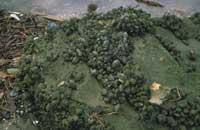
However, it is often more practical to analyze the structure of the entire ecosystem by quantifying living things to know the state of ecosystems. The importance or ecological significance of the aforementioned mussel balances is thus found. The balances that form the bivalves of the genus Mytilus are considered “elite structures”, since they leave and protect the life of other species. Although the formation of these communities is a consequence of overcoming the spatial problem, it can offer additional advantages: a) to the same mussels: with a sufficient reduction of the water stream the filtration is facilitated; b) to the rest of the animals of the community: it offers protection and substrate for a large number of animals, both mobile and adhered; the new current flows they generate ensure the power supply; the fauna of the bivalves and the diordetritus.
Therefore, although often found in contaminated places, the number of invertebrate species in these structures can be very high. We might think that biodiversity is also very high, but the latter does not always have to be true. If we select diversity indices when measuring the diversity of living beings in a habitat, in addition to the number of species, we measure the distribution between individuals or different biomass species. Figure 1 shows a very graphic example in which different points have been sampled along a gradient of pollution on the coast. As the level of pollution increases, we can observe a "typical" decline in the number of species, but the measured diversity index suffers a very important decrease in the mussel balance zones. Behind this paradox is the superiority of the huge mussel biomass. We talk about key species when the main characteristics of the community and the structure itself are under one or a few species. In the case of Mytilus we can say that we have a key species.
In the balances of these bivalves considered as “high-level competitors”, as we have said, the number of invertebrates can reach extreme values, up to hundreds of species. Suchan has studied these communities well and, as he has explained, in these enriched communities three layers can be distinguished (see figure 2): 1- Matrix of shells of live and dead mussels, which can be a simple layer or be formed by several layers of animals; 2- Sediment accumulated under the mussels; 3- Set of living beings of great diversity. The third layer has no form of layer, since they are animals that inhabit the other two layers mentioned. And it is that in any slit we find some crab. Another spectacular example of the latter is the well-known case of Mytilus, a group of animals that live on their shells, who hasn't seen them when eating mussels?
Disturbance and succession, ecological
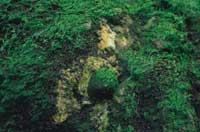
In the ecology of the coast we can see two other interesting concepts that I would not like to mention. The two, when we talk about mussels, have a very appropriate place and understanding their dependence is not difficult. Ecological succession would be defined as the pattern of continuous colonization and destruction in a direction that suffers a population in one place and does not occur depending on the seasons of the year. The following example will give some light to this long phrase: in the new hard substrate of the intertidal area, probably some type of algae (usually green) will begin to grow earlier.
Soon after, it will be turn of herbivores, and so we will check at ease walks around seaweed of flap gasteropod molluscs. In the openings that open behind these inert animals the appearance of the cirripedes mentioned above will be possible, since the plankton larva contains the waters. Next to them, the larvae of the mussels will arrive and stick to the substratum with microscopic algae filaments. From there, and in full competition with other living beings, they will gain most of the space if the physical conditions we already know are met.
Although over time some mussels will die, they are expected younger, and in this dynamic way we will find a similar community in the coming years. We take for granted a certain “stability”. However, to start the process of succession it will be necessary to have a new substrate (as in the example) or “clean”. Natural cleanings in some areas can be due to waves and in the case of bivalve balances are quite common. In the same way, due to the weight of the mussels, the sections of half a square meter can go to the water, appearing clear.
These kinds of events have been called “disturbance” and are just events that eliminate most of the biomass in a community. As a consequence of these events the coastal continuity breaks, for an area of medium size, all the stages of the succession are revealed and, ultimately, there is an increase in biodiversity. From this perspective, they are the way in which nature gives choice to each species to the natural disturbance of ecosystems. Something similar we find in the natural fires that suffer both the Mediterranean vegetation and the forests of American conifers...
As you have seen, reader, although we have been able to delve a little into the life of our Mytilus mussels, we have used these animals as tools to introduce only the tip of the nose in the coastal ecology. The excuse of mussels, therefore, of the coastal ones that can be so complex in marine ecosystems, has only sketched some brushstrokes. Or, according to the title, we mentioned a lot of curiosities. And there have been eleven, tell us if not!
Figure: As the level of contamination increases along a pollution gradient, we can observe a “typical” decrease in the number of species in the intertidal communities, but the measured diversity index shows a very significant decrease in the areas of mussel balances. Behind this paradox is the superiority of the huge mussel biomass.
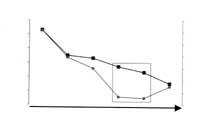
Figure: Polychromatous (Paprodromo) Polycrustacean (Polyampods); Crustacean Polyampods (Polyampods); Crustacean Polyampods (Paprodric); White Tripod); Tricofracean (Cernipod); Cernipods (Cerco); “The mussels are marked.

Gai honi buruzko eduki gehiago
Elhuyarrek garatutako teknologia




